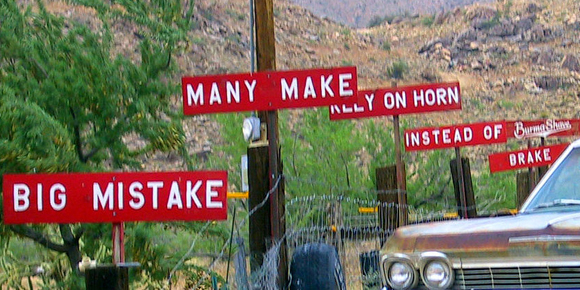As a kid, do you remember travelling in the U.S. by car and getting all excited about trying the American breakfast cereals that we would see advertised on U.S. TV, but which were, at that time, not always available in Canada? We were thrilled about actually eating Cheerios for the first time. Well, things were simpler back then. A lot simpler.
The other novel thing on the U.S. road was seeing the wide array of Burma Shave signs dotting the American countryside? Do you recall any of those silly little verses?
They were small red signs with white letters. Five signs, about 100 feet apart, each containing one line of a four line couplet, and, of course, the obligatory fifth sign advertising Burma Shave, a popular U.S. shaving cream.
Here are a few of the actual signs:
Don’t loose your head
To gain a minute
You need your head
Your brains are in it
— Burma Shave
Drove too long
Driver snoozing
What happened next
is not amusing
— Burma Shave
Brother speeder
Let’s rehearse
All together
Good morning nurse
— Burma Shave
Speed was high
Weather was not
Tires were thin
X marks the spot
— Burma Shave
No matter the price
No matter how new
The best safetydevice
In the car is you
— Burma Shave
A guy who drives
A car open wide
Is not thinkin’
He’s just hoping
— Burma Shave
At intersections
Look each way
A harp sounds nice
But it’s hard to play
— Burma Shave
Both hands on the wheel
Eyes on the road
That’s the skillful
Driver’s code
— Burma Shave
The one who drives when
He’s been drinking
Depends on you
To do his thinking
— Burma Shave
Car in ditch
Driver in tree
The moon was full
And so was he
— Burma Shave
Passing school zone
Take it slow
Let our little
Shavers grow
— Burma Shave
Also under the heading “nostalgia,” consider these reminiscences of days gone by:
• Back around the early 1950s, the North American population was about 170 million. And yet, you knew more people then, and knew them better.
• The average annual salary was under $3,000, but our parents could put some of it away for a rainy day and still live a decent life.
• A loaf of bread cost about 15-cents, but it was safe for a five-year-old to rollerskate to the store and buy one.
• TV was in black and white. “Prime-Time” meant I Love Lucy, Ozzie and Harriet, Gunsmoke, Father Knows Best, and Lassie. And hardly anyone had heard of ratings.
• We didn’t have air-conditioning, so the windows stayed up and half a dozen mothers ran outside when you fell off your bike.
• The only hazardous material you knew about was a patch of thorns in the bush at the corner.
• You loved to climb into a fresh bed because sheets were dried on the clothesline.
• People generally lived in the same hometown with their relatives, so childcare meant grandparents or aunts and uncles.
• Parents were respected and their rules were law. Children didn’t talk back.
• Your dad knew how to adjust everybody's carburetor and the dad next door knew how to adjust all the TV knobs.
• Your grandma grew beans in the back yard and maybe even chickens behind the barn.
• And just when you were about to do something really bad, chances were you’d run into your high school coach, or the nosy old lady from up the street, or your little sister’s piano teacher, or somebody from church, all of whom knew your parents’ phone number and your first name.
Those were the days of Nancy Drew, The Hardy Boys, Laurel & Hardy, Abbott & Costello, Sky King, Little Lulu comics, Howdy Doody and The Peanut Gallery, The Lone Ranger, The Shadow Knows, Roy and Dale, Trigger and Buttermilk, Pat Brady and Nellie Belle.
These were the days when you’d hear a lawn mower on Saturday morning, but it would be a reel-type, because rotary mowers hadn't been invented. Summers were filled with bike rides, playing cowboys, hide and seek, fishing in that local stream, kick-the-can, Simon says, baseball games, and learning to play golf. There were amateur shows at the local theatre before the Saturday matinee, lemonade stands, bowling, visits to the pool and Kool-Aid.
Almost seems like yesterday, eh? Almost.



